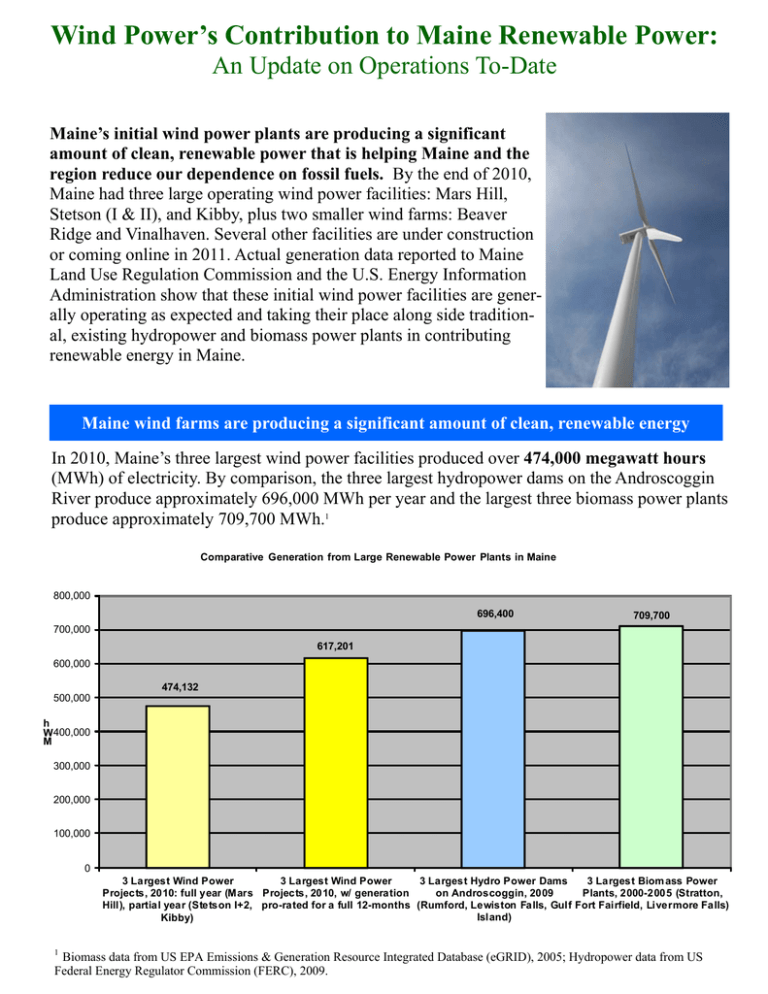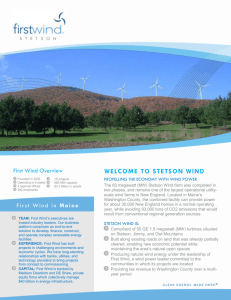Facts about Maine wind power generation
advertisement

Wind Power’s Contribution to Maine Renewable Power: An Update on Operations To-Date Maine’s initial wind power plants are producing a significant amount of clean, renewable power that is helping Maine and the region reduce our dependence on fossil fuels. By the end of 2010, Maine had three large operating wind power facilities: Mars Hill, Stetson (I & II), and Kibby, plus two smaller wind farms: Beaver Ridge and Vinalhaven. Several other facilities are under construction or coming online in 2011. Actual generation data reported to Maine Land Use Regulation Commission and the U.S. Energy Information Administration show that these initial wind power facilities are generally operating as expected and taking their place along side traditional, existing hydropower and biomass power plants in contributing renewable energy in Maine. Maine wind farms are producing a significant amount of clean, renewable energy In 2010, Maine’s three largest wind power facilities produced over 474,000 megawatt hours (MWh) of electricity. By comparison, the three largest hydropower dams on the Androscoggin River produce approximately 696,000 MWh per year and the largest three biomass power plants produce approximately 709,700 MWh.1 Comparative Generation from Large Renewable Power Plants in Maine 800,000 696,400 709,700 700,000 617,201 600,000 474,132 500,000 h W 400,000 M 300,000 200,000 100,000 0 3 Largest Biom ass Power 3 Largest Hydro Power Dams 3 Largest Wind Power 3 Largest Wind Power Plants, 2000-2005 (Stratton, on Androscoggin, 2009 Projects, 2010: full year (Mars Projects, 2010, w/ generation Hill), partial year (Stetson I+2, pro-rated for a full 12-months (Rumford, Lewiston Falls, Gulf Fort Fairfield, Livermore Falls) Island) Kibby) 1 Biomass data from US EPA Emissions & Generation Resource Integrated Database (eGRID), 2005; Hydropower data from US Federal Energy Regulator Commission (FERC), 2009. Stetson Wind Farm In 2010, Maine’s wind power facilities reduced global warming pollution by displacing fossil fuel generation (generally natural gas)—by approximately 230,000 tons of CO2 .2 This is equivalent to CO2 pollution from burning 20 million gallons of heating oil, or driving 40,000 average cars in a year. Stetson did not become fully operational (including Stetson II) until March 2010 and Kibby until October 2010. Therefore, 474,000 MWh does not represent a full typical year’s generation from these projects. Simply pro-rating the actual generation across a full calendar year would equal 617,000 MWh. Actual generation in 2010 is equivalent to the amount of electricity used by 67,700 average Maine households each year. (Pro-rated for a full-year, this would equal 88,200—or 15 percent of—Maine homes.) Maine’s wind power facilities that have operated for an entire 12-month period are generating approximately as much energy as predicted during permitting (Mars Hill 2008-2010: 86% of predicted; Stetson I 2010: 92%; Vinalhaven 2010: 104%). 2 Based on ISO-NE 2009 Marginal Emissions Report Learn more about these and other Maine wind projects on our website: http://www.nrcm.org/?p=7421 At a Glance: Maine’s Operating Wind Farms Stetson Wind Farm Kibby Wind Farm Photo: Fox Islands Wind Beaver Ridge Wind Farm Mars Hill Wind Farm Vinalhaven Wind Farm Mars Hill Wind Farm Photo: Reed & Reed Wind Power Facility Start-up Date Generation (MWh) % of # of Homes could Avoided CO2 (tons) Estimated * be powered 2008 Mars Hill, 2008 March 15, 2007 128,635 90% 18,376 59,815 2009 Mars Hill, 2009 Stetson I, 2009 Jannuary 22, 2009 121,166 138,969 85% 91% 17,309 19,853 56,342 64,621 120,949 155,723 44,934 85% 92% 69% 1 17,278 22,246 6,419 72,411 20,894 152,526 77% 2 21,789 70,925 12,105 486,237 474,132 104% 1,729 69,462 67,733 5,629 169,859 164,230 2010 Mars Hill, 2010 Stetson I, 2010 Stetson II, 2010 Kibby, 2010 Vinalhaven, 2010 Total 2010 Total (3 large projects) Total (2008-2010) March 15, 2010 October 15, 2010 (full operation) December 1, 2009 875,007 350,637 * Comparison between estimates from permit applications and actual generation pro-rated for a full calendar year. 1 In 2010 Stetson II came online after the windiest months of the year (Jan & Feb). 2 In 2010 the second half of Kibby came online after 9 months, including the windiest months (Jan & Feb). Wind Energy is an Essential Part of Maine’s Energy Plan Maine people don’t usually see the power plants that produce much of the energy we use; however, we do live with the effects. The status quo, with too much oil, coal and gas, is resulting in air pollution that threatens public health, mercury contamination that threatens wildlife, landscape destruction, and pollution that increases the threat of catastrophic climate change. Wind power is not a panacea for our energy problems. In reality, there is no silver bullet that can lead to an 80% reduction in fossil fuel use by 2050, as recommended by the world’s top scientists. Each source of energy has impacts. For example, biomass plants contribute to air pollution and may rely on unsustainable forest practices; hydropower dams can block fish passage and impair ecosystems. Even these renewable energy sources, with fewer impacts than fossil fuel sources, have trade-offs. Making progress on Maine’s wind power goals is an important component—along with maximizing energy efficiency, reducing power plant emissions and increasing vehicle fuel economy—for increasing Maine’s energy independence, reducing pollution, and stabilizing and lowering energy costs. Extensive independent studies demonstrate that wind power, one of the most cost-effective large-scale sources of new renewable power, reduces global warming pollution as it displaces electrical generation from fossil fuels.3 The manager of New England’s power grid, ISO-NE, has found that increasing the region’s use of wind power to 20% would reduce power plant global warming pollution by 25%.4 (Power plants remain the single largest source of global warming pollution in the region.) Every wind power project must be carefully sited to minimize impacts to the human and natural environment. Although wind power must be located where the wind is, some locations will be inappropriate—and no power plant can come without some trade-offs. 3 4 See NRCM Renewable Energy Library: http://www.nrcm.org/renewable_library.asp ISO-NE New England Wind Integration Study, 2010. p. 26.




